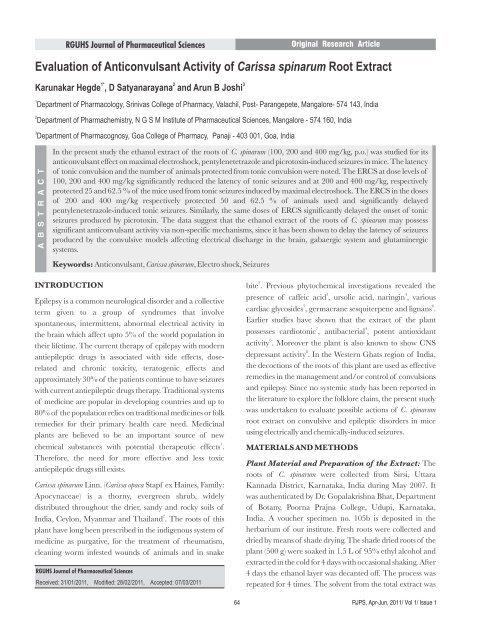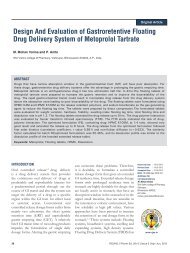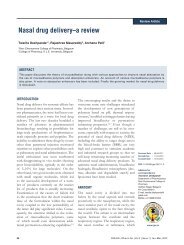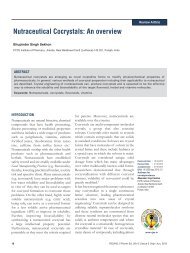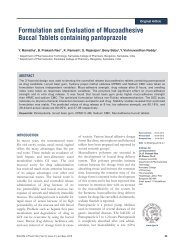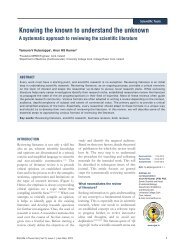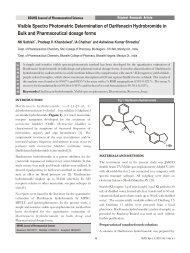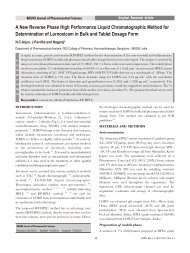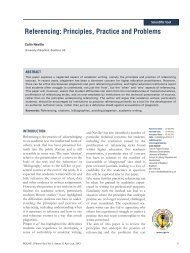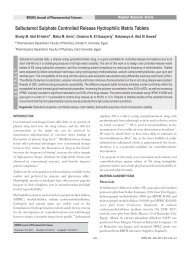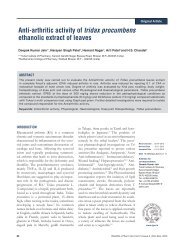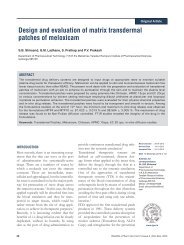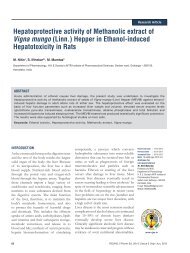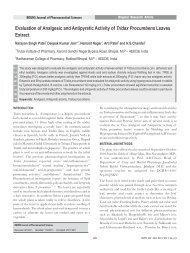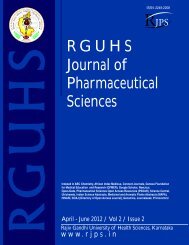final .cdr
final .cdr
final .cdr
You also want an ePaper? Increase the reach of your titles
YUMPU automatically turns print PDFs into web optimized ePapers that Google loves.
RGUHS Journal of Pharmaceutical Sciences<br />
Evaluation of Anticonvulsant Activity of Carissa spinarum Root Extract<br />
1* 2 3<br />
Karunakar Hegde , D Satyanarayana and Arun B Joshi<br />
1 Department of Pharmacology, Srinivas College of Pharmacy, Valachil, Post- Parangepete, Mangalore- 574 143, India<br />
2 Department of Pharmachemistry, N G S M Institute of Pharmaceutical Sciences, Mangalore - 574 160, India<br />
3 Department of Pharmacognosy, Goa College of Pharmacy, Panaji - 403 001, Goa, India<br />
A B S T R A C T<br />
INTRODUCTION<br />
Epilepsy is a common neurological disorder and a collective<br />
term given to a group of syndromes that involve<br />
spontaneous, intermittent, abnormal electrical activity in<br />
the brain which affect upto 5% of the world population in<br />
their lifetime. The current therapy of epilepsy with modern<br />
antiepileptic drugs is associated with side effects, doserelated<br />
and chronic toxicity, teratogenic effects and<br />
approximately 30% of the patients continue to have seizures<br />
with current antiepileptic drugs therapy. Traditional systems<br />
of medicine are popular in developing countries and up to<br />
80% of the population relies on traditional medicines or folk<br />
remedies for their primary health care need. Medicinal<br />
plants are believed to be an important source of new<br />
1<br />
chemical substances with potential therapeutic effects .<br />
Therefore, the need for more effective and less toxic<br />
antiepileptic drugs still exists.<br />
Carissa spinarum Linn. (Carissa opaca Stapf ex Haines, Family:<br />
Apocynaceae) is a thorny, evergreen shrub, widely<br />
distributed throughout the drier, sandy and rocky soils of<br />
2<br />
India, Ceylon, Myanmar and Thailand . The roots of this<br />
plant have long been prescribed in the indigenous system of<br />
medicine as purgative, for the treatment of rheumatism,<br />
cleaning worm infested wounds of animals and in snake<br />
Original Research Article<br />
In the present study the ethanol extract of the roots of C. spinarum (100, 200 and 400 mg/kg, p.o.) was studied for its<br />
anticonvulsant effect on maximal electroshock, pentylenetetrazole and picrotoxin-induced seizures in mice. The latency<br />
of tonic convulsion and the number of animals protected from tonic convulsion were noted. The ERCS at dose levels of<br />
100, 200 and 400 mg/kg significantly reduced the latency of tonic seizures and at 200 and 400 mg/kg, respectively<br />
protected 25 and 62.5 % of the mice used from tonic seizures induced by maximal electroshock. The ERCS in the doses<br />
of 200 and 400 mg/kg respectively protected 50 and 62.5 % of animals used and significantly delayed<br />
pentylenetetrazole-induced tonic seizures. Similarly, the same doses of ERCS significantly delayed the onset of tonic<br />
seizures produced by picrotoxin. The data suggest that the ethanol extract of the roots of C. spinarum may possess<br />
significant anticonvulsant activity via non-specific mechanisms, since it has been shown to delay the latency of seizures<br />
produced by the convulsive models affecting electrical discharge in the brain, gabaergic system and glutaminergic<br />
systems.<br />
Keywords: Anticonvulsant, Carissa spinarum, Electro shock, Seizures<br />
RGUHS Journal of Pharmaceutical Sciences<br />
Received: 31/01/2011, Modified: 28/02/2011, Accepted: 07/03/2011<br />
64<br />
2<br />
bite . Previous phytochemical investigations revealed the<br />
3 4<br />
presence of caffeic acid , ursolic acid, naringin , various<br />
5 6<br />
cardiac glycosides , germacrane sesquiterpene and lignans .<br />
Earlier studies have shown that the extract of the plant<br />
7 4<br />
possesses cardiotonic , antibacterial , potent antioxidant<br />
6<br />
activity . Moreover the plant is also known to show CNS<br />
8<br />
depressant activity . In the Western Ghats region of India,<br />
the decoctions of the roots of this plant are used as effective<br />
remedies in the management and/or control of convulsions<br />
and epilepsy. Since no systemic study has been reported in<br />
the literature to explore the folklore claim, the present study<br />
was undertaken to evaluate possible actions of C. spinarum<br />
root extract on convulsive and epileptic disorders in mice<br />
using electrically and chemically-induced seizures.<br />
MATERIALS AND METHODS<br />
Plant Material and Preparation of the Extract: The<br />
roots of C. spinarum were collected from Sirsi, Uttara<br />
Kannada District, Karnataka, India during May 2007. It<br />
was authenticated by Dr. Gopalakrishna Bhat, Department<br />
of Botany, Poorna Prajna College, Udupi, Karnataka,<br />
India. A voucher specimen no. 105b is deposited in the<br />
herbarium of our institute. Fresh roots were collected and<br />
dried by means of shade drying. The shade dried roots of the<br />
plant (500 g) were soaked in 1.5 L of 95% ethyl alcohol and<br />
extracted in the cold for 4 days with occasional shaking. After<br />
4 days the ethanol layer was decanted off. The process was<br />
repeated for 4 times. The solvent from the total extract was<br />
RJPS, Apr-Jun, 2011/ Vol 1/ Issue 1


